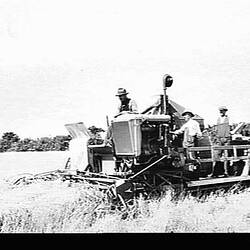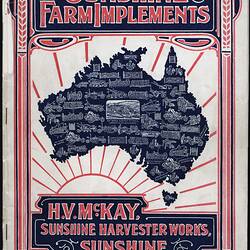Summary
The image depicts part of an experimental fully-mechanised large-scale production of cereal crops using the most up-to-date farming equipment, using tractors, tractor implements, including disc ploughs, and an auto header imported from H.V. McKay, Massey Harris Pty Ltd, manufactured by the Sunshine Harvester Works in Victoria, Australia - one of the first self-propelled combine harvesters to be trialled in the United Kingdom. The exercise was conducted by Dr T.C. Neville, a retired London medical practitioner, and H.H. Scott, a farmer from the Victorian Mallee country with extensive experience in Australian broad-acre farming methods and the Australian-designed equipment employed.
The WA-Type Sunshine Auto Header depicted was an entirely self-contained harvester powered by an on-board 32 horsepower four-cylinder Wisconsin petrol engine and gearbox driving the machine through the nearside (driver's left-hand) front wheel, giving two forward speeds of two and three miles per hour, and one in reverse. The same engine also powered the machinery of the harvester which in a single process combined the gathering, reaping, elevating, threshing, winnowing and sieving of cereal crops saving the cleaned grain in an on-board 6 bushel capacity hopper or 'grain bin' from which it could be bagged by 1 or 2 assistants working on a bagging-off platform while the machine was moving. The trial took placed on a 1,500-acre leased property of Knighton Manor, at Broad Chalke, on the Salisbury Plains of Wiltshire, and in its first season saw the successful harvesting of 530 acres of wheat crops and 150 acres of barley.
In the good Wiltshire growing conditions at Knighton Manor, the auto header proved capable of harvesting from 28 to 36½ acres per day, with its 12-ft wide cutting head covering 4.36 acres per hour when travelling continuously at the top speed of 3 miles per hour. In one instance the auto header managed to harvest 530 sacks of grain (each of 252 lbs weight) in a single 9½-hour working day, with an average yield of 14½-sacks per acre, gathering the grain at a rate of almost a bag a minute. In the lighter conditions of many Australian wheat crops, W-type Sunshine Auto Headers often achieved harvesting rates of 40 to 50 acres per day.
According to an inscription in the McKay Archives held by Museums Victoria, prints of the Knighton Manor trial photographs were posted to A. Street, of Wilton, Wilshire, England, in August 1941, by H.S.Taylor, designer of the auto header.
Description of Content
An imported Australian-made WA-Type Sunshine Auto Header undertaking a trial harvest of crops on 'Knighton Manor' farm at Board Chalke, near Salisbury, in Wiltshire, England, 1934. The self-propelled machine was powered by a Wisconsin petrol engine mounted behind the radiator on the near-side of the harvester (on the left-hand of the operator or driver). The machine was guided by a steering wheel which turned a small rear trailing wheel. The standpipe with a circular head air filter was designed to prevent dust and fragments of straw being drawn into the carburetor in the engine air intake. Two men working as assistants are standing on the bagging platform behind the engine, one wearing a peaked cap and overalls is standing watching with hands on hips, while the second man with a brimmed hat is fitting a sack or bag to the bagging shoot. Empty hessian bags waiting to be filled are hanging on the railing beside the bagging platform. Described in the original caption as a 'down crop', the heavy yielding growing conditions at Knighton Manor had caused many of the ears of wheat in the ripe standing crop to be hanging down in 'goose-neck style'. To avoid 'necking' of the wheat, in which a portion of the drooping ears fell to the ground as they were cut and were thus lost, attachments known as 'crop lifters' were fitted to the front of the auto header. The crop lifters consisted of a series of horizontally positioned long curved teeth or fingers which passed under the drooping ears as auto header moved through the crop, gently raising the heads into the adjustable comb which straightened the necks so the heads were standing erect as they were fed into the reciprocating knife (like a reaping machine cutter bar). The heads of grain and attached portion of the stalks thus removed by the cutting head were gathered by double revolving steel spiral conveyors which fed them to a central elevator, to be raised into the threshing drum. On this machine the front elevator panel is decorated with the 'Sunshine' brandname and an impressed pattern of radiating sun rays painted in alternating red and yellow colours, which had formed a distinctive part of H.V. McKay's 'Sunshine' branding since 1905.
More Information
-
Collection Names
-
Collecting Areas
-
Acquisition Information
Donation from Massey Ferguson Iseki Australia Ltd, by Mar 1995
-
Place & Date Depicted
Broad Chalke, Salisbury, Wiltshire, England, Great Britain, 1934
-
Format
Photograph, Black & White
-
Inscriptions
Original Title/Caption in Album: 'AUTO HEADER AT WORK IN DOWN CROP OF WHEAT ON MR H.H.SCOTT'S FARM'
-
Model Name or Number
-
Brand Names
-
Classification
Agriculture & rural life, Crop management - harvesting, Auto header harvesters
-
Category
-
Discipline
-
Type of item
-
Keywords
Agricultural Equipment, Auto Header Harvesters, Cereal Crops, Export Trade, Harvesting Equipment, Header Harvesters, Self-Propelled Combine Harvesters, Wheat Farming



